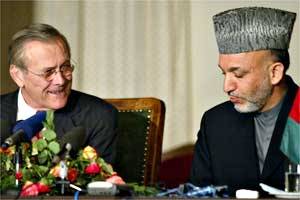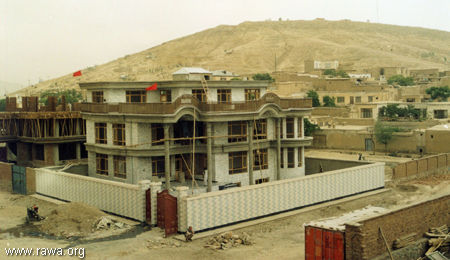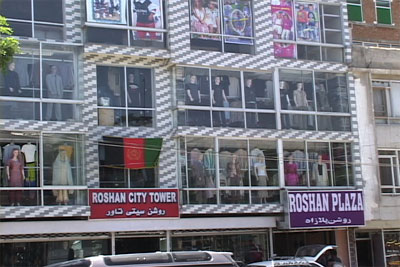In Afghanistan, Selling War As Peace
by Marc W. Herold
Departments of Economics and Women's Studies
Whittemore School of Business & Economics
University of New Hampshire
POSTED SEPTEMBER 6, 2004 --
On May Day, 2003, U.S. Defense Secretary Donald Rumsfeld announced in Kabul that the U.S. had "ended major combat activity" in Afghanistan and a period of stability was beckoning. His faithful executor, Hamid Karzai, sat at his side with some prophetically sagging flowers between the pair. The U.S. corporate media dutifully transcribed this "truth."1

Rumsfeld and Karzai at the Presidential Palace in Kabul (B.K. Bangashap/AP photo in Time Online Edition, May 6, 2003)
One year and some $40 billion later2, an assessment can be made.
The following data presents a summary of what it looked like in an Afghanistan "after major combat activity." Between 1,350 and 1,600 people (including some in the Pakistani border areas where the Afghan conflict spilled over into) had been killed. Around 350 civilians had died in the continuing conflict. Around 55 U.S. and European soldiers had died (more than in the "combat" phase of the U.S. intervention), as had 500-600 Afghan soldiers and police.3 Is all this caused by mere "remnants" of a defeated Taliban?
Table Summary of Deaths Caused by Conflict in Afghanistan, June 2003 - May 20044
| Afghan/Pakistani civilian deaths | 340-361 |
| Afghan/Pakistani military deaths | 596-703 |
| U.S. and Allied military deaths | 54-55 |
| Taliban and allies killed | 365-481 |
| Totals | 1,355 - 1,600 |
The one striking "success" of the United States has been its ability to get Afghans to do the fighting and be killed. This year has been a difficult one for an Afghan soldier serving the Karzai regime, much more deadly than being a Taliban or Al Qaeda member. For every Euro-American soldier who died, 10-13 Afghan troops were killed. "Afghanization" has been carried out with a vengeance, repeating the U.S. effort at Vietnamization. For every U.S. soldier killed in the Afghan theater, the Taliban/Al Qaeda has suffered 7-9 deaths - a relatively low ratio by historical standards.
The low level of U.S. military deaths and the almost total absence of reporting in U.S. mainstream media about on-the-ground activity have served the Bush Administration well. As Mike Whitney wrote,
"It doesn't matter if the country is already a "basket case" (as a visiting British MP described Afghanistan last week) just as long as the flag draped coffins aren't being dumped off in Dover twice a week."5
The reference was here to a comment made in May 2004 by Eric Illsley, a Labour Party member of the Foreign Affairs Select Committee which visited Afghanistan.6
How could the upcoming Afghan "elections"7 be sold to the American public if people were aware of the widespread fighting and death? The signifier must be detached from the signified. The new real is produced and marketed.
Does anyone really believe that on-the-ground reality in Afghanistan will change after October 9, 2004? October 9, 2004 will be for U.S. consumption, a veritable post-modern spectacle. Huge problems of vote-buying, intimidation, extremely biased resource availability to candidates (with Karzai and some Northern Alliance thugs holding the disproportionate amounts), the holding by one person of many voter cards8, etc., but most importantly, how can a western-style election be realistically carried out in an environment where illiteracy rates are extremely high, and rampant violence abounds?9 More males are registered to vote as of August 25th then the number of eligible male voters. Indeed, the U.N. continually adjusts upwards its numbers of eligible voters!10 An Afghan voting card sells for $100 today. What did Karzai have to say at a press conference (attended to by Rumsfeld too)?
"If Afghans have two registration cards and if they would like to vote twice - well, welcome! This is an exercise in democracy. Let them exercise it twice."11
A strong case can surely be made that these elections have much less to do with Afghan reality and much more to do with U.S. presidential electoral politics.12 Karl Rove and George Bush sorely need an "Afghan success story" (as Iraq remains in dire turmoil) to parade before the U.S. electorate one month before the November elections.13 Such parading has already begun with the Bush campaign advertisements referring to the "two more free nations" -- Afghanistan and Iraq -- competing in the Athens Olympics.14 A further indicator of how Afghan elections are for U.S. consumption is revealed in U.S. pressures to have the voting take place before November.15 As Seymour Hersh put in early 2004, in an interview about a New Yorker article he wrote:
"The idea is that the White House will be able to say, 'Look, we can make democracy... we went to Afghanistan, we've got the war, and it's now a democratic country; it'll happen in Iraq, too.'"16
An Afghan election spectacle serves the Bush re-election effort.
The neglect by the major U.S. media in reporting Afghan dead represents a continuation of the trend which began on October 8, 2001. As we have argued time-and-again, for the mainstream media and many humanitarian organizations, some bodies are worthy and others are not.17 But some exceptions exist in the mainstream media. For example, in constructing the data base presented in the Table above, the news reports from the field written by David Brunnstrom, Carlotta Gall, Stephen Graham, Noor Khan, Hamida Ghafour, David Rohde18 , and Amir Shah have been invaluable, not to mention those provided by Pakistani journalists such as Behroz Khan of The News, Syed Saleem Shahzad of The Asia Times, and Rahimullah Yusufzai.
The Taliban/Al Qaeda forces recognize that a long drawn-out conflict serves them, as a Taliban once put it to a Westerner, you have a watch but time is on our side. Donor fatigue and war weariness will arise in the technologically-sophisticated West.19 But time alone would be insufficient. Small-scale, geographically dispersed attacks upon well-chosen targets are necessary. The age-old guerrilla strategy of never engaging a superior enemy upon his terrain must be strictly followed -- something U.S. soldiers do not seem to understand when they whine about how "coward" and "invisible" is the enemy. The western reconstruction effort needs to be slowed-down and the presence of culturally-insensitive U.S soldiers heightened.20 The U.S. patrols in Humvees, the search and break-ins into homes, build anti-American sentiments which congeal in a growing civilian support base for the Taliban especially in southern and eastern Afghanistan.
Afghanistan's low population density, the prior mujahideen and Taliban experiences as movements and not state actors, the largely denuded landscape, and the country's fragmented clan-village rural society make that the guerrilla struggle is different from that in Vietnam then and Iraq today. It is sporadic, low-level, small-scale and completely decentralized. Uruzgan is not Fallujah and Kandahar is not Hue.
When the United States military started establishing provisional reconstruction teams (PRTs) -- reminiscent of the U.S. Civic Action Teams in Vietnam -- in mid-2003, the effect was to mix-up aid efforts and military goals, a blending loudly decried by both the international aid community and even the United Nations.21 Recently, the U.S. military even suggested that armed escorts should be provided to humanitarian workers, an idea angrily dismissed by most aid agencies.22 The effect of such blurring was completely predictable as the Taliban began striking out at NGO facilities and aid workers.23 Since March 2003, close to fifty aid workers have been killed in Afghanistan. When five doctors of the Medicins Sans Frontieres (MSF) were killed by the Taliban in June 2004, the MSF decided to leave the country after having been there for twenty-five years (including during the anti-Soviet conflict and the Taliban years). The head of the MSF mission criticized the blurring of the lines between independent humanitarian work and military objectives by the United States.24 As an example, he pointed to a widely distributed U.S. leaflet which said that the population would have to provide information about the Taliban and Al Qaeda if they wanted aid deliveries to continue, i.e. schools and wells for intelligence. As a Lt. Reid Finn put it while standing in a bleak, dust-covered village,
"The more they help us find the bad guys, the more good stuff they get."25
On September 1, 2004, 34 aid organizations announced in Kabul that they were increasingly being targeted by militant attacks because of the blurring between military operations and aid work in the country. The groups blamed the deliberately created confusion singling out for particular criticism the PRTs.26
In this year, the Taliban and Al Qaeda have begun using two deadly new weapons, well-suited to the given military correlation of forces: remote-controlled improvised explosive devices (IEDs) and the occasional suicide bomber.27 Both have killed U.S, European and Afghan troops.
The second part of this assessment looks briefly at the kind of society being "reconstructed" in Afghanistan.28 In May 2004, veteran reporter of the Afghan scene, Kathy Gannon, wrote an op-ed titled, "The Wrong Way to Build a Nation," castigating U.N. efforts on the criteria of development, self-governance, ethnic and religious rapprochement and security.29 The U.N. program to disarm soldiers in Afghanistan has been a "big failure."30 Repatriation of refugees is pursued,
"While tens of thousands of Afghans who have returned from Pakistan and Iran since the first days following the fall of the Taliban still live in the direst conditions in Kabul..these refugees still live in precarious slums while Mr. Karzaiís friends and cabinet members are building multi-million dollar compounds for themselves and while billions of dollars from donor countries stream in for Afghanistan's 'reconstruction.'"31
A returned refugee spectacle is marketed to the world public.
Since the American takeover of Afghanistan, the major crops are now opium, human organs and kidnapped children.32 Drugs reign and warlords-turned-government ministers act as a toll-gate on (foreign) resource flows. Sometimes less gentle means are used such as in September 2003 when numbers of Karzai's cabinet and his military officers organized the bulldozing and forced eviction of poor squatters on valuable real estate lands in the Wazir Akbar Khan/Sherpur neighborhood.33

The new mansions arising in the Sherpur district.
The bulldozers came and went and a few months later, the spectacle of the nouveau riche mansions sprouting up like concrete mushrooms from Afghan dust and rubble under Karzai's reconstruction was there for all to behold. Even the United Nations offered a timid critique of these evictions driven by greed.34
In effect, a highly class and urban-biased "reconstruction" effort is taking place. Beside, disconnected from, and in spite of the Karzai "Intercontinental model,"35 a vast, dynamic, small-scale informal sector is thriving engaged in market activity, buying and selling, rebuilding (from homes to brick-making to orchards in the Shomali Plains, etc.), and generating means of daily survival. Individual entrepreneurship has accomplished some reconstruction, but there is no serious countrywide reconstruction.36
Christina Lamb captured the essence of the class-bias in her article "Sipping Margaritas in the Rubble of Kabul," in the New York Times.37 She begins her account with
"'Look, the swimming pool is in the shape of a martini glass,' boasts Alex as he shows several visitors around his soon-to-be-opened hotel cum-blackjack lounge."
For his part, Karzai donned a hard-hat and with his entourage of armed U.S. DynCorp guards, inaugurated the building of the five-star Hyatt Regency Hotel in Kabul (fittingly located opposite the U.S. Embassy), a media spectacle.38
"Development" in the Karzai vision is also represented by visible glamour projects (like the Kabul-Kandahar highway) and the new, luxury five-story department store, the Roshan Center, in downtown Kabul built by a returnee who had lived in Britain for 25 years and who now has his own private 150-man militia to help get things done in Karzai's Afghanistan. In April, Kabul announced that a western-style amusement park replete with Ferris wheel was going to be built in historic Zarnegar Park.39 And there's more good news: Kabul got a new steakhouse in March 2004.40

photo provided by Tom Jackson, 2004.
Hamida Ghafour writes about how a Western-style sin city is sprouting up in Kabul.41 The Hooters Calendar Girl team on a tour named "Let Freedom Wing"42 provided a spectacle at Bagram Air Base in June 2004 to "boost troop morale" and in Kandahar even took up arms:
The planned election day of October 9th marks three years after the Bush Administration began its bombing and invasion of Afghanistan, which we now know was merely a step on the way to its real target: Saddam Hussein in Iraq.
Letís briefly look at what happened on the ground that day as the spectacle of Afghanistan being "liberated" and put on the path to "democracy" began being sold to the American public. On October 9, 2001, General Myers proclaimed to a gullible U.S. public that the U.S. had essentially "achieved air supremacy over Afghanistan."43 But, the Afghan air force and air defenses were in effect non-existent. U.S. warplanes bombers fired four "precision" projectiles at Radio Shariat on Kabul's TV Mountain close to the center of the city, killing an undetermined number of civilians. Four Tomahawk cruise missiles were fired at a defunct radio tower in northeastern Kabul, but one missed and struck the U.N.'s Afghan Technical Consultancy building, killing four night watchmen and injuring four other civilians. Another missile hit a home in Deh Sabz village, north of Kabul, destroying houses and injuring members of the Nazim and Ullah Khan families.44 Another U.S. "precision" bomb aimed at what was believed to be an Al Qaeda camp in Maiwand, west of Kandahar, killed one civilian. A B-2 dropped a 5,000 pound "bunker buster" GBU-37B hard case penetrator bomb upon an area of Kandahar city believed to have underground bunkers.45 Other U.S. bombs destroyed three Ariana Airlines civilian planes at Logar airport (including a Boeing 727).
Bombs continue to fall, villages continue to be raided, homes continue to be broken into by U.S. troops, innocents continue to be abducted (and some tortured in the Afghan gulag46), prisoners continue to languish in Afghan jails under conditions for some which "violate every standard of human rights," even according to the U.N.47, Afghans continue to die, the Taliban continue to attack government personnel and buildings, opium continues to expand as the crop of choice accounting for almost one-half of Afghanistanís gross domestic product48, corruption is rampant at every levelm money talks in Afghanistan's scramble for reconstruction49, and the margaritas flow in the bloated expatriate, aid, contractor, security, NGO, returnee community in Karzai's mayoralty.
In what must qualify as the penultimate spectacle, the man chosen by George Bush to succeed the Taliban, the man flown into his own country in U.S. Special Ops aircraft and then flown out when the Taliban were on his royal heels, the man tightly protected by the 5th U.S. Special Forces Group then and DynCorp now, and the man who is responsible for all the above, was awarded the U.S. Liberty Medal in Philadelphia on July 4, 2004.
-- 30 --
Footnotes
1. See for example the reports in Fox News, CNN and the Associated Press: "Rumsfeld Declares Major Combat Over in Afghanistan," Fox News (May 1, 2003), "Rumsfeld: Major combat over in Afghanistan," CNN.com.World (May 1, 2003), and "Rumsfeld declares combat over in Afghanistan," Associated Press (May 1, 2003).
2. Linda Bilmes, "Bush's Gamble on the Afghan Front," Financial Times (March 31, 2004).
3. Some recruits have apparently made the calculation wand absconded. More than 3,000 soldiers of the new Afghan National Army have deserted, see Thalif Deen, "Army Desertions Cause Problems: Afghan Elections," Dawn (March 13, 2004). The new, U.S-trained Afghan National Army has thus lost a quarter of its recruits.
4. Monthly and daily details may be found in my database. In the Table above I report "exact" numbers, though these are indicative of orders of magnitude.
5. Mike Whitney, "The Afghanistan Failure," CounterPunch (June 2, 2004).
6. Colin Brown and Kim Sengupta, "Afghanistan, the Order the World Forget," The Independent (May 25, 2004).
7. The notion of spectacle comes from Guy Debord and Jean Baudrillard, theorist of hyper-realism. In 1991, Baudrillard wrote his provocative La Guerre du Golfe n'a Pas Eu Lieu (Paris: Galilee, 1991), in which he argued that the 100-300,000 dead Iraqis in the first Gulf War simply did not exist insofar as they did not appear on the TV cathode tube. The video representation of the Gulf War became the war itself, supplanting any kernel of reality with simulation.
8. See Carol Harrington and Jared Ferrie, "Afghan Vote Threatens Bush's Credibility," Toronto Star (August 17, 2004).
9. See Sudha Ramachandran, "Afghans Get to Vote, Sort Of," Asia Times (July 16, 2004).
10. See Martin Huckerby, "Afghan Voting Number Puzzle," BBC News (August 26, 2004)
11. "Here's another voter we've found, sergeant," SW-UK (August 25, 2004). See also Martin Huckerby, "Afghan Voting Number Puzzle," BBC News (August 26, 2004)
12. Peter Symonds, "The US Prepares Another Democratic Charade in Afghanistan," WSWS (August 4, 2004).
13. Bilmes, op. cit.
14. Liz Sidotti, "Bush Launches New Olympics Campaign Ad," Associated Press (August 13, 2004). See the photo.
15. See Ansar Rahel, "When Elections Threaten Democracy," New York Times (July 20, 2004).
16. Seymour Hersh, "The Other War. Why Bush's Afghanistan Problem Won't Go Away," The New Yorker (April 12, 2004).
17. See for example my "The Bombing of Afghanistan as a Reflection of 9/11 and Different Valuations of Life," at and Edward Herman, "'Body counts' in Imperial Service: Yugoslavia, Afghanistan, and Elsewhere" (unpublished manuscript. 2002).
18. See for example Eric Schmitt and David Rohde, "Afghan Rebels Widen Attacks," New York Times (July 31, 2004).
19. An excellent description of the moral weariness which sets in on once gung-ho U.S. soldiers is Ryung Suh, "In Afghanistan: a US soldier's emotional landscape," Christian Science Monitor (April 12, 2004).
20. And this is occurring, see David Brunnstrom, "Reality blurs Bush's rosy Afghan vision," Dawn (June 17, 2004).
21. For a concrete example of such blending, see David Rohde, "New U.S. Tactic in Afghanistan Has Old Ring," New York Times (March 31, 2004). See also Anne Penketh, "How the US blurred the line between aid and the armed forces," The Independent (July 29, 2004).
22. "Aid Workers in Afghanistan Slam US Call to Use Armed Guards," Agence France-Presse (August 8, 2004).
23. See "Aid bodies in crossfire of US war on terror," Business Day.
24. Imogen Foulkes, "Mounting Obstacles for Aid Workers," BBC News.
25. Rohde, op. cit.
26. Rachel Morarjee, "Aid workers accuse Afghan authorities, armed forces of putting them in danger," Agence France-Presse (September 1, 2004).
27. See Carlotta Gall, "Remote-Control Explosions Pose Threat in Afghanistan," New York Times (August 21, 2004). On suicide attacks and also the widespread anti-Karzai insurgency, see Mark Sedra, "Are the Taliban Really 'Gone'?" Foreign Policy in Focus (March 10, 2004).
28. I have examined this in an earlier article, "AfghaniScam", on the Bubble Economy in Karzai's Afghanistan.
29. In Los Angeles Times (May 18, 2004). Others have made a similar assessment, see Jay Shaft, "Afghanistan: Not Just a Failure, An Outright Humanitarian Disaster," Scoop (June 12, 2003).
30. See Hamida Ghafour, "UN Program to Disarm Soldiers in Afghanistan 'Big Failure'," The Globe and Mail (June 5, 2004). By August 2004, only 10,000 out of 60,000 militiamen had turned in their weapons (see Duncan Campbell, "This Malign Spell Has Yet to be Broken," The Guardian (July 21, 2004)).
31. Dr. Assem Akram, op. cit.
32. Jane Stillwater, "'American' Afghanistan's Thee Major Crops: Opium, Human Organs and Children," The Baltimore Chronicle (August 27, 2004).
33. See a file of articles covering the land grab by Karzai regime officials.
34. "UN Report: Thousands of Afghans Forcibly Evicted From Their Homes," Voice of America (April 11, 2004).
35. See my "Karzai & Associates' Trickle-Down Reconstruction".
36. Dr. Assem Akram, "Ailing Afghanistan Still Not Recovering: Change the Doctor," The Afghan Observer (August 26, 2004).
38. "Karzai Hails New Afghan Hyatt," Seattle Post-Intelligencer (April 17, 2004 with photo of Karzai in hard hat by Emilio Morenatti). See text. Further details in "Project Ground Breaking of the Hyatt Regency Hotel in Kabul, Afghanistan".
39. Mohammad Jawes Sharifzada, "Amusement Park Coming to Kabul," IWPR (April 29, 2004).
40. Scott Baldauf, "What's Hot and Sizzling in Kabul? The New Steakhouse," Christian Science Monitor (March 26, 2004).
41. Hamida Ghafour, "A Sin City Sprouts in Kabul," Los Angeles Times (July 11, 2004). See also Yashwant Raj, "Sex and Liquor in Afghanistan," Hindustan Times (February 29, 2004).
42. See Hooters report on the tour.
43. See my "Postmodern Gestures of [in]Significance: Proclaimed U.S. Air Supremacy Over Afghanistan".
44. See "Raids Restart with 76 Reported Dead," The Guardian (October 10, 2001).
45. The GBU-37B made by Northrup-Grumman uses the BLU-113 warhead suspected of containing uranium. "In "Dying of Thirst" (New Scientist 17 Nov 2001) it was reported that US forces were using Bunker Buster bombs on the underground aqueduct network in Afghanistan suspected as Taliban locations. If the 2 ton GBU-37 penetrators are depleted uranium then the public health and environmental consequences could be grim. Weapons of indiscriminate effect? " (from here )
46. Duncan Campbell and Suzanne Goldenberg, "'They said this is America . . . if a soldier orders you to take off your clothes, you must obey'," The Guardian (June 28, 2004). For a detailed account with photos see the report in France's Le Monde, "Human Rights Watch Denonce: Le government des Etats-Unis pratique la torture de maniere routiniere contre les prisoniers, et viole systematiquement les Conventions de Geneve," Le Monde Diplomatique (Avril 2004).
47. "UN Slams "Inhuman" Conditions of Afghan Jail," 4NI-UK (August 24, 2004).
48. David Rohde, "Poppies Flood Afghanistan: Opium Tide May Yet Turn," New York Times (July 1, 2004)
49. Hafizullah Gardish, "Corruption Rampant at Every Level. Citizens Complain That Nothing in the Country Can Be Accomplished Without Paying Someone a Bribe," IWPR (May 28, 2004). See also Tanya Goudsouzian, "Money talks in Afghanistan's scramble for reconstruction," The Daily Star (Lebanon) (August 27, 2004).

